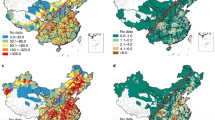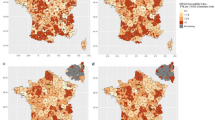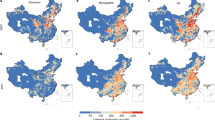Abstract
Background
The growth of concentrated animal feeding operations (CAFOs) has caused significant environmental detriments and raised concerns regarding environmental justice with CAFOs exposure.
Objective
This study examined environmental disparities in exposure to CAFOs with several environmental justice related variables and considered exposure intensity.
Methods
We obtained data on permitted CAFOs (July 2021) from the Wisconsin Department of Natural Resources. We used Census tract level variables from the 2010 Census to evaluate environmental disparities by environmental justice related variables (i.e., percentages of Non-Hispanic White, Non-Hispanic Black, or Hispanic; percentage living below the poverty level; median annual household income; income inequality (Gini index); percentage with education less than high school diploma; racial isolation (RI) for Non-Hispanic Black; and educational isolation (EI) for population without a college degree). We assessed exposure to CAFOs as the sum of animal units (AUs) within each Census tract and investigated exposure disparities by comparing distributions of environmental justice related variables based on CAFO status (i.e., never, expired, or current) and Census tract-level CAFOs exposure intensity categories (i.e., from low exposure (quartile 1) to high exposure (quartile 4)).
Results
CAFOs in Wisconsin were generally located in areas with lower percentages of racial minority persons and high SES communities; however, within the areas with current CAFO exposure, areas with high CAFOs exposure intensity had higher percentages of non-Hispanic Black and Hispanic, and lower percentages of non-Hispanic White populations compared to areas with low CAFOs exposure.
Impact statement
-
This study compared distributions of CAFO exposure and multiple environmental justice related variables and considered exposure intensity based on animal units for CAFOs exposure metric. Although CAFOs in Wisconsin were generally located in areas with lower percentages of racial/ethnic minority subpopulations and high SES communities, we found complex disparities with higher exposure for disadvantaged communities within areas with CAFOs. This work adds to the existing evidence that some populations such as racial/ethnic minority populations may face disproportionate burdens from CAFOs.
This is a preview of subscription content, access via your institution
Access options
Subscribe to this journal
Receive 6 print issues and online access
$259.00 per year
only $43.17 per issue
Buy this article
- Purchase on Springer Link
- Instant access to full article PDF
Prices may be subject to local taxes which are calculated during checkout


Similar content being viewed by others
Data availability
All data for environmental justice related variables are publicly available from the Census Bureau’s website. Data on CAFOs are available through a request to the Wisconsin Department of Natural Resources.
References
United States Department of Agriculture (USDA). 2019. National Agricultural Statistics Service https://www.nass.usda.gov/ [accessed 7 April 2022].
US EPA. Risk assessment evaluation for concentrated animal feeding operations. Washington DC: US Environmental Protection Agency; 2004.
Fisher JA, Freeman LEB, Hofmann JN, Blair A, Parks CG, Thorne PS, et al. Residential proximity to intensive animal agriculture and risk of lymphohematopoietic cancers in the agricultural health study. Epidemiology. 2020;31:478–89.
Schultz AA, Peppard P, Gangnon RE, Malecki KM. Residential proximity to concentrated animal feeding operations and allergic and respiratory disease. Environ Int. 2019;130:104911.
Son JY, Miranda ML, Bell ML. Exposure to concentrated animal feeding operations (CAFOs) and risk of mortality in North Carolina, USA. Sci Total Environ. 2021;799:149407.
Williams CM. CAFOs: Issues and development of new waste treatment technology. Penn St Envtl L Rev. 2002;10:217–48.
Heaney CD, Myers K, Wing S, Hall D, Baron D, Stewart JR. Source tracking swine fecal waste in surface water proximal to swine concentrated animal feeding operations. Sci Total Environ. 2015;511:676–83.
Wilson SM, Serre ML. Examination of atmospheric ammonia levels near hog CAFOs, homes, and schools in Eastern North Carolina. Atmos Environ. 2007;41:4977–87.
Miralha L, Muenich RL, Schaffer-Smith D, Myint SW. Spatiotemporal land use change and environmental degradation surrounding CAFOs in Michigan and North Carolina. Sci Total Environ. 2021;800:149391.
Lenhardt J, Ogneva H. Environmental injustice in the spatial distribution of concentrated animal feeding operations in Ohio. Environ Justice. 2013;6:133–9.
Son JY, Muenich RL, Schaffer-Smith D, Miranda ML, Bell ML. Distribution of environmental justice metrics for exposure to CAFOs in North Carolina, USA. Environ Res. 2021;195:110862.
Wilson SM, Howell F, Wing S, Sobsey M. Environmental injustice and the Mississippi hog industry. Environ Health Perspect. 2002;110:195–201.
Carrel M, Young SG, Tate E. Pigs in space: determining the environmental justice landscape of swine concentrated animal feeding operations (CAFOs) in Iowa. Int J Environ Res Public Health. 2016;13:849.
Galarraga J, Khanjar N, Berman I, Hall J, Edwards C, Bara-Garcia S, et al. Environmental injustice and industrial chicken farming in Delaware. New Solut. 2021. https://doi.org/10.1177/10482911211052944.
USDA, 2017. 2017 Census of Agriculture State profile. https://www.nass.usda.gov/Publications/AgCensus/2017/Online_Resources/County_Profiles/Wisconsin/cp99055.pdf [accessed 14 November 2021].
United States Department of Agriculture (USDA). 2019. Milk production, National Agricultural Statistics Service https://usda.library.cornell.edu/concern/publications/h989r321c?locale=en [accessed 12 May 2022].
Raff Z, Meyer A. CAFOs and surface water quality: evidence from Wisconsin. Am J Agr Econ 2022;104:161–89.
US EPA. Learn about environmental justice. https://www.epa.gov/environmentaljustice/learn-about-environmental-justice [accessed 20 May 2022].
California Office of environmental health hazard assessment (OEHHA). https://oehha.ca.gov/calenviroscreen/report/calenviroscreen-30 [accessed 20 May 2022].
Bravo MA, Leong MC, Gelfand AE, Miranda ML. Assessing disparity using measures of racial and educational isolation. Int J Environ Res Public Health. 2021;18:9384.
Wing S, Cole D, Grant G. Environmental injustice in North Carolina’s hog industry. Environ Health Perspect. 2000;108:225–31.
Hall J, Galarraga J, Berman I, Edwards C, Khanjar N, Kavi L, et al. Environmental injustice and industrial chicken farming in Maryland. Int J Environ Res Public Health. 2021;18:11039.
Mirabelli MC, Wing S, Marshall SW, Wilcosky TC. Race, poverty, and potential exposure of middle-school students to air emissions from confined swine feeding operations. Environ Health Perspect. 2006;114:591–6.
Radon K, Schulze A, Ehrenstein V, van Strien RT, Praml G, Nowak D. Environmental exposure to confined animal feeding operations and respiratory health of neighboring residents. Epidemiology. 2007;18:300–8.
Smit LA, Hooiveld M, van der Sman-de Beer F, Opstal-van Winden AW, Beekhuizen J, Wouters IM, et al. Air pollution from livestock farms, and asthma, allergic rhinitis and COPD among neighbouring residents. Occup Environ Med. 2014;71:134–40.
Acknowledgements
We would like to thank the Wisconsin Department of Natural Resources for providing data on CAFOs.
Funding
This publication was developed under Assistance Agreement No. RD835871 was awarded by the U.S. Environmental Protection Agency to Yale University. It has not been formally reviewed by EPA. The views expressed in this document are solely those of the authors and do not necessarily reflect those of the Agency. Research reported in this publication was supported by the National Institute on Minority Health and Health Disparities of the National Institutes of Health under Award Number R01MD012769. The content is solely the responsibility of the authors and does not necessarily represent the official views of the National Institutes of Health.
Author information
Authors and Affiliations
Contributions
JYS designed the work, collected the data, conducted the analyses, interpreted the results, drafted the manuscript, and revised the manuscript. MLB designed the work, interpreted the results, revised the manuscript, and supervised the work.
Corresponding author
Ethics declarations
Competing interests
The authors declare no competing interests.
Additional information
Publisher’s note Springer Nature remains neutral with regard to jurisdictional claims in published maps and institutional affiliations.
Supplementary information
Rights and permissions
Springer Nature or its licensor (e.g. a society or other partner) holds exclusive rights to this article under a publishing agreement with the author(s) or other rightsholder(s); author self-archiving of the accepted manuscript version of this article is solely governed by the terms of such publishing agreement and applicable law.
About this article
Cite this article
Son, JY., Bell, M.L. Concentrated animal feeding operations (CAFOs) in relation to environmental justice related variables in Wisconsin, United States. J Expo Sci Environ Epidemiol (2023). https://doi.org/10.1038/s41370-023-00598-y
Received:
Revised:
Accepted:
Published:
DOI: https://doi.org/10.1038/s41370-023-00598-y



